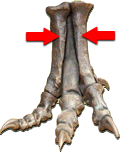
An arctometatarsus (or arctometatarsalian condition) is a feature in the feet of some theropod dinosaurs where the middle one (MT III) of three weight-bearing metatarsals (the long bones between the ankle and the toes) is "pinched" between those either side of it (MT II and MT IV) and squeezed into a wedge shape that tapers towards the top end.
In extreme cases, the MT III becomes completely obscured from view before it reaches the ankle, but there are many subtle steps in the evolution of this feature across several theropod families.
The exact function of the arctometatarsus is unknown, but paleontologists suspect it evolved in critters with a need for speed, perhaps as some kind of shock absorber. Alvarezsaurids, troodontids, caenagnathids, ornithomimids, and some oviraptorosaurs were blessed with an arctometatarsus of varying degrees, and they're all built for good running. Tyrannosauroids have it too. It's the foot of Tyrannosaurus rex above.













